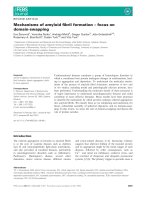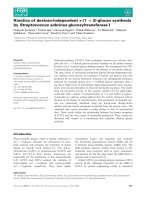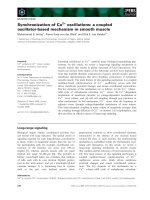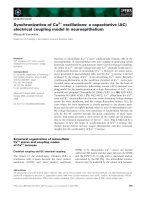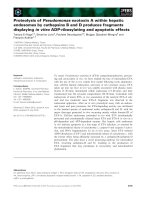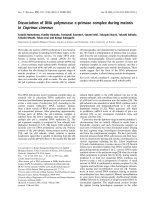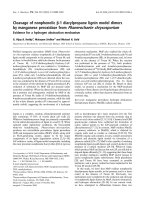Báo cáo khoa học: "Ectomycorrhization of Acacia holosericea A. Cunn. ex G. Don by Pisolithus spp. in Senegal: Effect on plant growth and on the root-knot nematode Meloidogyne javanica Robin Duponnois" potx
Bạn đang xem bản rút gọn của tài liệu. Xem và tải ngay bản đầy đủ của tài liệu tại đây (33.06 KB, 6 trang )
Original article
Ectomycorrhization of Acacia holosericea A. Cunn.
ex G. Don by Pisolithus spp. in Senegal:
Effect on plant growth and on the root-knot nematode
Meloidogyne javanica
Robin Duponnois
a*
, Hassna Founoune
a,d
, Amadou Bâ
b
, Christian Plenchette
c
,
Samir El Jaafari
d
, Marc Neyra
e
and Marc Ducousso
f
a
IRD, Laboratoire de Biopédologie, BP. 1386 Dakar, Sénégal
b
ISRA/URA-Forêts, BP. 2312 Dakar, Sénégal
c
INRA, 17 rue Sully, 21034 Dijon, France
d
Université Moulay Ismaïl, Laboratoire de Biotechnologie et d’amélioration des plantes, BP. 4010 Meknes, Maroc
e
IRD, Laboratoire de Microbiologie, BP. 1386 Dakar, Sénégal
f
LSTM, BP. 5035 Montpellier, France
(Received 12 April 1999; accepted 6 December 1999)
Summary – The ectomycorrhization of Acacia holosericea with fungi isolated in Senegal (belonging to the Pisolithus genus) and their
effect on
Meloidogyne javanica have been studied. In 100 tree plantations of Eucalyptus camaldulensis, Casuarina equisetifolia,
Acacia mangium
and A. holosericea, 33 fruiting bodies of the ectomycorrhizal fungus Pisolithus were collected and cultured under
axenic conditions. Only four fungal isolates have induced the formation of typical ectomycorrhizae with
A. holosericea under axenic
conditions. One of these, COI 024, increased plant development under glasshouse conditions and decreased the multiplication of the
root-knot nematode
Meloidogyne javanica. The mechanisms involved in these interactions and the potential use of the ectomycorrhizal
symbiosis in agroforestry programs are being discussed.
Pisolithus / Meloidogyne / ectomycorrhizae / leguminous trees / Senegal
Résumé
– Ectomycorhization de Acacia holosericea A. Cunn. ex G. Don par Pisolithus spp. au Sénégal: effet sur le dévelop-
pement de la plante et sur la multiplication du nématode à galles
Meloidogyne javanica. L’effet de symbiotes fongiques ectomy-
corhiziens, appartenant au genre
Pisolithus et isolés au Sénégal, a été étudié sur la croissance de plants d’Acacia holosericea et sur le
développement d’un peuplement de nématodes phytoparasites
Meloidogyne javanica. Une enquête a été réalisée sur 100 arbres choi-
sis dans différentes plantations de
Eucalyptus camaldulensis, Casuarina equisetifolia, Acacia mangium et A. holosericea où trente trois
carpophores de
Pisolithus spp. ont été prélevés. Le mycélium issu de chaque carpophore a été cultivé en conditions axéniques et
chaque souche a été testée pour sa compatibilité avec des plants d’
A. holosericea. Seulement 4 isolats ont induit la formation d’ecto-
mycorhizes en conditions axéniques. Dans une expérience conduite en serre avec
A. holosericea, une souche, COI 024, a stimulé la
croissance de la plante hôte et inhibé la multiplication de
Meloidogyne javanica. Les mécanismes susceptibles d’être à l’origine de ces
phénomènes sont discutés et les effets bénéfiques potentiels du recours à la mycorhization contrôlée dans les programmes agrofores-
tiers sont exposés.
Pisolithus / Meloidogyne / ectomycorhize / legumineuse / Sénégal
Ann. For. Sci. 57 (2000) 345–350 345
© INRA, EDP Sciences
* Correspondence and reprints
Tel. (221) 849 33 28; Fax. (221) 832 16 75; e-mail:
R. Duponnois et al.
346
1. INTRODUCTION
The population explosion in sahelian areas of West
Africa has led to a restructuring of traditional agricultur-
al systems using more intensive but unsustainable sys-
tems over-exploiting the natural resources. The decrease
in soil fertility in Sub-Saharan Africa, particulary with
deficiencies of N and P, remains the most significant
result of this practice.
It is well known that trees can potentially improve soil
characteristics through a number of processes, such as
nitrogen fixation, maintenance of soil organic matter, etc.
These influences are well studied in agroforestry systems,
such as alley cropping [20] or parklands [3].
Nitrogen-fixing legumes and leguminous tree species,
such as
Acacia, play a major role in environmental pro-
tection and in the local economies of dry and semi-arid
tropical Africa [8, 9, 17]. The Acacia species remain very
abundant in savannas and arid regions of Australia,
Africa, India and the Americas. They generally are
dependent on mycorrhizae for the absorption of nutrients
required for their growth and for nitrogen fixation [4, 6,
7, 18]. One of the fast-growing leguminous trees, brought
from Australia and introduced in Western Africa, Acacia
holosericea, has been studied in Senegal. This species
forms endomycorrhizae and/or ectomycorhizae [1, 7, 10].
This tree species and its bacterial or fungal symbionts
appears to be well adapted to the Senegal climatic condi-
tions [7]. However, it has recently been shown that A.
holosericea was very susceptible to root-knot nematodes
(Meloidogyne spp.) [13] which are major pests of veg-
etable crops in tropical areas. Therefore, Acacia species
may increase the occurrence and abundance of root knot
nematodes in agroforestry systems and decrease the
potential benefits (for plantation trees and adjacent crops)
of this agronomical practice.
As it is known that mycorrhizal fungi can reduce the
effects of root-knot nematodes [12], the present study was
initiated to investigate the association of
A. holosericea
with ectomycorrhizal fungi with emphasis on the effect of
this fungal symbiosis on the plant development, and
the relationships between the root-knot nematode
M. javanica (Treub) Chitwood and an ectomycorrhizal
fungus (Pisolithus sp.) on A. holosericea.
2. MATERIALS AND METHODS
2.1. Isolating fungi into axenic conditions
The occurrence of fruit bodies of the ectomycorrhizal
fungus Pisolithus was investigated from 100 tree planta-
tions of Eucalyptus camaldulensis, Casuarina equisetifo-
lia, A. mangium and A. holosericea. Sporocarps were
detected in thirty three of these tree plantations.
Sporocarps were brushed free of adhering soil and frac-
tured carefully in a laminar flow hood. A small amount of
tissue was then removed with a fine forceps and placed on
MNM agar medium in a Petri dish (Melin and Norkrans
modified by Marx) [21]. The fungal cultures were incu-
bated at 25 °C in the dark and subcultured until all cont-
aminating microorganisms were eliminated. Pure fungal
cultures were initiated with 21 fruiting bodies.
2.2. Preliminary compatibility testing
2.2.1. Axenic culture of A. holosericea seedlings
The compatibility between the fungal isolates and
A. holosericea was tested using the paper-sandwich tech-
nique [5]. Seeds of A. holosericea were surface – steril-
ized with concentrated sulphuric acid (36 N) for 60 min.
The acid solution was then decanted off and the seeds
rinsed and imbibed for 12 h in four rinses of sterile dis-
tilled water. Seeds were then transferred aseptically in
Petri dishes filled with 1% (w:v) water agar medium.
These plates were incubated for 1 week at 25 °C. When
the radicles had grown to 1 cm, the seedlings were trans-
ferred into large (15-cm-diameter) plastic Petri dishes.
These plates were filled with a mineral salt agar medium
[11, 24]. Its composition per litre was as follows: MgSO
4
,
7H
2
O: 150 mg; (NH
4
)
2
HPO
4
: 125 mg; CaCl
2
.2H
2
O:
50 mg; KCl: 108 mg; agar: 20 g; distilled water: 1 litre.
The micronutrients (Fe, Mo, B, Mn, Cu and Zn) were
added together as 0.1 ml of a concentrated commercial
solution: Kanieltra (COFAZ, BP 198-08, 75261 Paris
Cedex, France). The surface of the agar medium was cov-
ered with an autoclaved Whatman (120 °C, 20 min) No. 1
filter paper (125-mm-diameter). Young seedlings (three
per plate) were then placed on the filter paper near the
edge of the plate. Another sterile paper filter, cut across
the top, was laid over the radicule but not the colyledons.
The plates were sealed with plastic adhesive tape and
placed upside down at a 45° angle in a climate-controlled
growth chamber with a constant 16 h photoperiod with
240 µE.m
–2
.s
–1
at 25 °C.
2.2.2. Preparation of fungal inoculum
and axenic mycorrhizal synthesis
The fungal isolate was maintained on MNM agar
medium. After one month culturing at 25 °C in the dark,
about five fungal plugs, taken from the margin of the
colonies, were placed on an autoclaved square (6 × 6 cm)
of paper card laid over the MNM agar medium in 9-cm-
diameter Petri dishes. These plates were then incubated at
Ectomycorrhization of Acacia holosericea in Senegal
347
25 °C in the dark in order to achieve a good coverage of
the paper card.
The filter paper covering the roots was removed and
the mycelium colonizing the paper card was placed on the
root. Subsequently the plates were incubated under the
same conditions as described above. There were three
replicates per fungal treatment. After 2 weeks culturing,
the Petri dishes were opened and the root systems were
observed under a stereomicroscope (magnification ×120)
to confirm the presence of ectomycorrhizas.
2.2.3. Preparation of root samples
for microscopy observations
Ectomycorrhizae were confirmed by a microscopic
study to check formation of a Hartig net between epider-
mal cells. For each treatment, 10 lateral roots were fixed
overnight in 2% glutaraldehyde in 0.1 M sodium cacody-
late buffer (pH 7.2) at 4 °C and rinsed in the same buffer.
The roots were post-fixed for 1 h in 2% osmium tetroxide
and rinsed in distilled water. They were dehydrated
through an acetone series and three times in pure acetone.
They were then infiltrated by an acetone-Spurr’s resin
series and embedded in 100% Spurr’s resin. Transverse
sections (0.5 – 1 µm thick) were cut from embedded sam-
ples and stained with 0.05% toluidine blue in 1% sodium
tetraborate.
2.3. Effects of the fungal isolates on plant growth
and on M. javanica development
2.3.1. Fungal inoculum
The ectomycorrhizal fungus Pisolithus sp., isolate COI
024, was maintained on MNM agar medium [21]. This
fungal strain was choosen because of its high growth rate
in axenic conditions. The solid inoculum was prepared in
1.6 liter glass jars containing 1.3 liter vermiculite-peat
mixture (4:1, v:v) moistened with liquid MNM medium.
This substrate was inoculated with fungal plugs taken
from the margin of the fungal colonies. The jars were
then sealed and incubated for 6 weeks at 28 °C in the
dark.
2.3.2. Glasshouse experiment
Seeds of A. holosericea were from provenance Bel Air
(Dakar, Senegal) and desinfected as described before (see
preliminary compatibility testing). The germinated seeds
were individually grown in 0.5 dm
3
polythene bags (5-
cm-diameter) filled with autoclaved soil (140°C, 40 min).
The physicochemical characteristics of the soil were as
follows: pH H
2
O 6.5; clay 3.5%; fine silt 7.4%; coarse silt
25.4%; fine sand 36.6%; coarse sand 21.5%; total carbon
0.54%; total nitrogen 0.06% and Olsen phosphorus
0.88%. This soil was mixed with 10% (v:v) fungal inocu-
lum or 10% vermiculite-peat mixture (4:1, v:v) for the
control treatments without the fungus. The seedlings were
placed in a glasshouse during the hot season (35 °C day,
30 °C night, 12 h photoperiod) and watered twice a week
without fertiliser. The pots were placed in a randomized,
complete block design with ten replicates per treatment.
After one month culture, the seedlings were inoculated
with 5 ml suspensions of 0, 300 and 700 second stage
juveniles (J2) of M. javanica. In a preliminary trial, it has
been demonstrated that these 2 inoculum rates could
reduce the growth of A. holosericea seedlings [13]. The
inoculum of M. javanica was multiplied on tomato
(Lycopersicon esculentum Mill.) cv. Roma. After 2
month culturing, the tomato roots were harvested, cut into
short lengths and placed in a mist chamber for 1 week to
enable the nematode eggs to hatch [22].
Two months after nematode inoculation, when the
damage associated with the different inoculum densities
was observed, the plants were uprooted. The oven dried
(1 week at 65 °C) weight of the shoot was measured.
After drying, plant tissues were ashed (500 °C), digested
in 2 ml HCL 6N and 10 ml HNO
3
N, then analysed by
colorimetry for P [19], by flame emission for Na, K and
Ca and by atomic absorption for Cu, Mg, Fe. Plant tissues
were digested in 15 ml H
2
SO
4
36 N containing 50 g.l
–1
salicylic acid for N (Kjeldhal) determination. The root
systems were washed, cut into short pieces, mixed and the
percentage of ectomycorrhizal short roots (ectomycor-
rhizal rate: (number of ectomycorrhizal short roots/total
number of short roots) × 100) was determined under a
stereomicroscope (magnification: × 40) on a random
sample of at least 100 short roots. Root pieces were then
placed in a mist chamber for 2 weeks to recover hatched
juveniles [23]. The roots were oven dried (65 °C, 1 week)
and weighed. The data were analyzed with a one-way
analysis of variance. Mean values were compared using
Student’s t-test (P < 0.05). Nematode numbers were
log
10
(x + 1) transformed before statistical analysis. For
mycorrhizal rate, data were previously transformed by
Arcsinsqrt (x).
3. RESULTS
Most of the fruiting bodies were found in the E. camal-
dulensis plantations whereas one was associated with
A. mangium, one with Casuarina equisetifolia and two
with A. holosericea. Compatibility tests performed under
axenic conditions between A. holosericea and different
R. Duponnois et al.
348
fungal isolates showed that only 4 Pisolithus isolates
(COI 007, COI 024, COI 029 and COI 032) could induce
the formation of ectomycorrhizae with a yellow mantle
and a Hartig net.
In the glasshouse experiment, shoot growth was sig-
nificantly increased (P < 0.05) by the fungal isolate COI
024 inoculated alone (table I). No fungal effects were
recorded on the root biomass (table I). In the absence of
the nematodes, mycorrhizal symbiosis increased the leaf
mineral K and Mg concentrations (table II).
All
M. javanica inoculum densities had significantly
reduced shoot growth regardless of ectomycorrhizal fun-
gus treatment (table I). Root growth of the seedlings
without Pisolithus was not affected by the nematode
(table I). In contrast, root biomass of the mycorrhizal
plants was significantly higher (P < 0.05) in plants inoc-
ulated with nematodes (table I). Element concentrations
in leaves of seedlings parasitized by M. javanica were not
significantly different from the uninoculated controls
(without nematodes), except for Ca which was increased
with the inoculum 700 and 300 J2 in the treatments with-
out and with COI 024, respectively and for Na which was
increased in the treatments with nematodes but without
COI 024 (table II).
The ectomycorrhizal symbiosis reflected by the
mycorrhizal rate was not influenced by the root-knot
nematodes. In contrast, nematode reproduction was sig-
nificantly decreased by the ectomycorrhizal fungus
(table I).
4. DISCUSSION
One of the Pisolithus isolates, COI 024 dramatically
promoted plant growth (+ 142% in shoot biomass). It is
well known that ectomycorrhizal fungi improve plant
productivity in low fertility soils producing better miner-
al nutrient concentrations [2]. This biological effect was
demonstrated for other Australian acacia species such as
Table I. Effect of Meloidogyne javanica inoculum density and inoculation with Pisolithus sp. COI 024 on growth and ectomycor-
rhizal colonization of Acacia holosericea.
Mycorrhizal Number of Shoot biomass Root biomass Mycorrhizal
treatments inoculated (mg dry weight) (mg dry weight) rate (%)
nematodes
Without COI 024 0 (control) 1095 c
(1)
897 b 0
300 667 d 694 b 0
700 586 d 926 b 0
With COI 024 0 2646 a 1060 b 42.3 a
300 1501 b 1945 a 45.3 a
700 1346 bc 1741 a 39.8 a
(1)
: Values (means of ten replicates) in the same column followed by the same letter are not significantly different according to the Student “t” test
(P < 0.05).
Table II. Effect of Meloidogyne javanica inoculum density on the number of nematodes per plant and the leaf mineral concentrations.
Mycorrhizal Number of Number of Mineral concentrations (% of dry matter)
treatments nematodes nematodes
inoculated per plant
N P K Ca Na Cu Mg Fe
Without COI 024 0 (control) 0 ND
(2)
0.027 b 0.694 b 0.896 c 0.076 b 0.001 a 0.307 c 0.022 b
300 4185 a
(1)
ND 0.021 b 0.526 b 1.012 bc 0.124 a 0.0009 a 0.278 c 0.024 b
700 3905 a ND 0.034 b 0.641 b 1.386 ab 0.111 a 0.0009 a 0.363 bc 0.027 ab
With COI 024 0 0 1.82 a 0.056 ab 1.078 a 1.022 bc 0.049 b 0.001 a 0.454 ab 0.026 b
300 1384 b 1.55 a 0.087 a 1.130 a 1.461 a 0.069 b 0.001 a 0.515 a 0.029 ab
700 1088 b 2.01 a 0.062 ab 1.415 a 0.893 c 0.059 b 0.001 a 0.420 ab 0.039 a
(1)
: Values (mean of ten replicates) in the same column followed by the same letter are not significantly different according to the Student “t” test
(P < 0.05). (2) ND: not determined.
Ectomycorrhization of Acacia holosericea in Senegal
349
A. mangium [16]. The mean P concentration in leaves of
Acacia mycorrhized with COI 024 and infected or not by
M. javanica is about 2.5 fold higher than in the control
plants with or without M. javanica which could suggest
that this provenance of A. holosericea is ectomycorrhizal-
dependent.
The benefical effects of COI 024 on plant growth have
clearly been demonstrated throughout this experiment.
However, this type of symbiosis can be involved in other
beneficial processes, such as a protecting effect against
soil borne pathogens
[20].
In West Africa, several investigations have pointed out
that the root-knot nematode M. javanica may affect the
benefits resulting from growing A. holosericea [13–15],
especially in agroforestry systems, to the detriment of
adjacent susceptible crops. Our results indicate that the
ectomycorrhizal symbiosis with COI 024 suppresses the
development of this nematode and minimizes its patho-
genic effect. It is well documented that endomycorrhizal
fungi could inhibit the development of root-knot nema-
todes [12] but no data was available so far for the antag-
onistic effect of ectomycorrhizae against M. javanica.
The mechanism of this antagonism remains unknown.
Two types of fungal activity could explain this effect: (i)
physical and (ii) chemical. In the first case, the fungal
mantle which forms around the short roots could act as a
mechanical barrier preventing the penetration of the juve-
nile nematodes. In the second, some ectomycorrhizal
fungi, such as Pisolithus produce large quantities of
polyphenolic compounds which could decrease the via-
bility of eggs and juveniles. This second aspect has been
studied by Senghor [23] with 32 isolates of Pisolithus
collected from Australia and West Africa. Results indi-
cate that most of the fungal strains (30 isolates) inhibited
the eggs. The identification of these toxic compounds is
currently being undertaken.
In conclusion, this paper reports for the first time in
West Africa, a positive effect of the ectomycorrhizal
symbiosis with one strain of Pisolithus sp. COI 024 on
A. holosericea. The use of the fungal strain COI 024, iso-
lated in Senegal and therefore well adapted to climatic
conditions in Senegal, competitive against the indigenous
microflora, could contribute to the growth of
A. holosericea seedlings under nursery conditions.
However, further investigations should be made to
measure this fungal effect under field conditions and to
optimize this ectomycorrhizal symbiosis (screening of
efficient fungal strains; investigating mycorrhizal-depen-
dence of different provenances of A. holosericea, dual
inoculation with efficient strains of rhizobia).
Acknowledgements: The authors thank Mme
J. Mortier (INRA Dijon) for its technical assistance.
REFERENCES
[1] Bâ A.M., Piché Y., Dual in vitro rhizobial and ectomyc-
orrhizal colonization of
Acacia holosericea. In: Alexander I.J.,
Fitter A.H., Lewis D.H., Read D.J. (Eds.). Abstracts of the 3rd
European Symposium on Mycorrhizas, Mycorrhizas in
Ecosystems: Structure and function, CAB, London, 1992,
p. 112.
[2] Bolan N.S., A critical review on the role of mycorrhizal
fungi in the uptake of phosphorus by plants, Plant Soil 134
(1991) 189-207.
[3] Breman H., Kessler J.J., Woody plants in agro-ecosys-
tems of semi-arid regions, Springer-Verlag, Berlin, 1995.
[4] Brown M.S., Bethlenfalvay G.F., The Glycine-
Glomus-
Rhizobium
symbiosis. VI. Photosynthesis in nodulated, mycor-
rhizal, or N- and P-fertilized soybean plants, Plant Physiol. 85
(1987) 120-123.
[5] Chilvers G.A., Douglas P.A., Lapeyrie F., A paper-sand-
wich technique for rapid synthesis of ectomycorrhizas, New
Phytol. 103 (1986) 397-402.
[6] Colonna J.P., Thoen D., Ducousso M., Badji S.,
Comparative effects of
Glomus mosseae and P fertilized on
foliar mineral composition of
Acacia senegal seedlings inocu-
lated with
Rhizobium, Mycorrhiza 1 (1991) 35-38.
[7] Cornet F., Diem H.G., Étude comparative de l’efficacité
des souches de
Rhizobium d’Acacia isolées de sols du Sénégal
et effet de la double symbiose
Rhizobium-Glomus mosseae sur
la croissance de
Acacia holosericea et A. raddiana. Bois et
Forêts des Tropiques 198 (1982) 3-15.
[8] Cossalter C., Introducing Australian Acacias in dry, trop-
ical Africa. In: Turnbull J.W. (Ed.) Australian acacias in devel-
opping countries. Proceedings of an International Workshop at
the Forestry Training Center, Gympie, Australia 1986. ACIAR,
Camberra, 1986, pp. 118-122.
[9] Dreyfus B., Diem H.G, Freire J., Keya S.O.,
Dommergues Y.R., Nitrogen fixation in tropical agriculture and
forestry. In: Dasilva E.J., Dommergues Y.R., Nyns E.J.,
Ratledge C. (Eds.). Microbial technology in the developping
world. Oxford University Press, Oxford, 1987, pp. 1-7.
[10] Ducousso M., Importance des symbioses racinaires
pour l’utilisation des acacias d’Afrique de l’Ouest, Thèse de
l’Université Lyon 1, 1991, pp. 205.
[11] Duponnois R., Garbaye J., Techniques for controlled
synthesis of the Douglas fir-
Laccaria laccata ectomycorrhizal
symbiosis, Ann. Sci. For. 48 (1991) 239-251.
[12] Duponnois R., Cadet P., Interactions of
Meloidogyne
javanica
and Glomus sp. on growth and N2 fixation of Acacia
seyal.
A. A. J. Nematol. 4, 2 (1994) 228-233.
[13] Duponnois R., Cadet P., Senghor K., Sougoufara B.,
Étude de la sensibilité de plusieurs acacias australiens au néma-
tode à galles
Meloidogyne javanica, Ann. Sci. For. 54 (1997)
181-190.
[14] Duponnois R., Senghor K., Mateille T., Pathogenicity of
Meloidogyne javanica (Treub) Chitw. to Acacia holosericea
(A. Cunn. ex G. Don) and A. seyal (Del.), Nematologica 41, 4
(1995) 480-486.
R. Duponnois et al.
350
[15] Duponnois R., Tabula T.K., Cadet P., Étude des inter-
actions entre trois espèces d’
Acacia (Faidherbia albida Del.,
A. seyal Del., A. holosericea A Cunn. ex G. Don) et
Meloidogyne mayaguensis au Sénégal, Can. J. Soil Sci. 77, 3
(1997) 359-365.
[16] Duponnois R., Bâ A.M., Growth stimulation of
Acacia
mangium
Willd by Pisolithus sp. in some senegalese soils, For.
Ecol. Manag. (1999) 1-7.
[17] Giffard P.L., L’arbre dans le paysage sénégalais.
Sylviculture en zone tropicale sèche, Centre Technique
Forestier Tropical, Dakar, Sénégal (1974).
[18] Harris D., Pacovsky E.A., Paul E.A., Carbon economy
of soybean-Rhizobium-Glomus associations, New Phytol 101
(1985) 427-440.
[19] John M.K., Colorimetric determination in soil and plant
material with ascorbic acid, Soil Sci. 68 (1970) 171-177.
[20] Kang B.T., Alley cropping-soil productivity and nutri-
ent recycling, For. Ecol. Manag. 91 (1997) 75-82.
[21] Marx D.H., The influence of ectotropic mycorrhizal
fungi on the resistance of pine roots to pathogenic infections. I.
Antagonism of mycorrhizal fungi to root pathogenic fungi and
soil bacteria, Phytopathology 59 (1969) 153-163.
[22] Seinhorst J.W., De betekenis van de toestand van de
grond voor het optreden van aanstasting door het stengelaaltje
Ditylenchus dipsaci Kühn Filipjev, Tijdschrift over
Plantenziekten 56 (1950) 292-349.
[23] Senghor K., Étude de l’incidence du nématode phy-
toparasite Meloidogyne javanica sur la croissance et la sym-
biose fixatrice d’azote de douze espèces d’Acacia (Africains et
Australiens) et mise en évidence du rôle des symbiotes endo et
ectomycorhiziens contre ce nématode. Thèse de doctorat de
3
e
cycle, Université Chekh Anta Diop, Dakar, Sénégal (1998)
p. 128.
[24] Shemakanova N.M., Mycotrophy of woody plants,
Academy of science of USSR, Springfield (1962) pp. 329.


